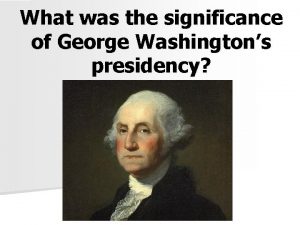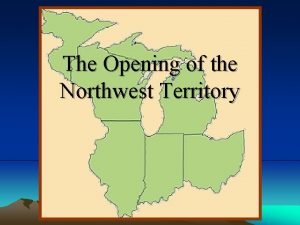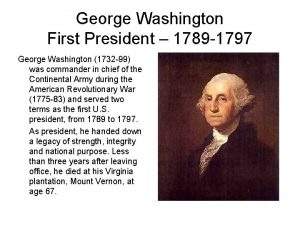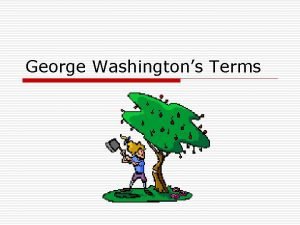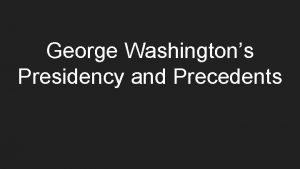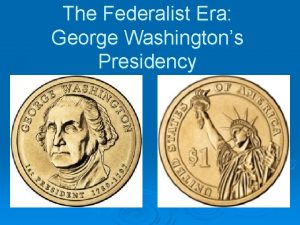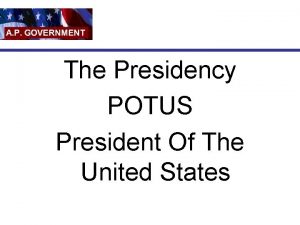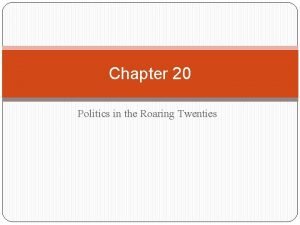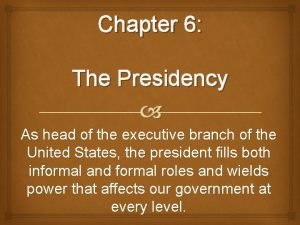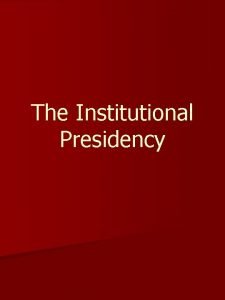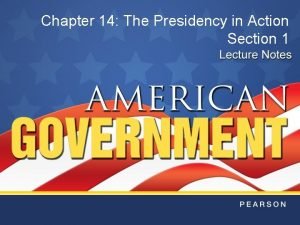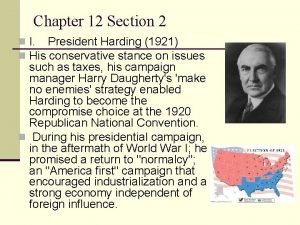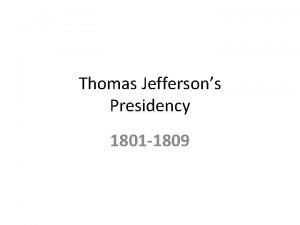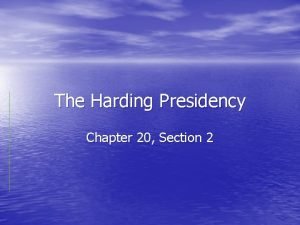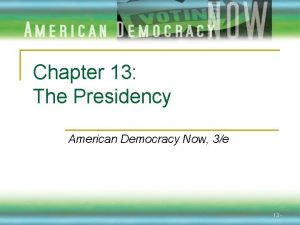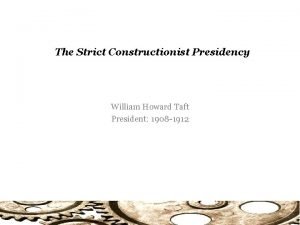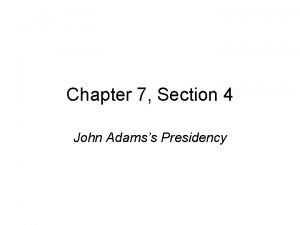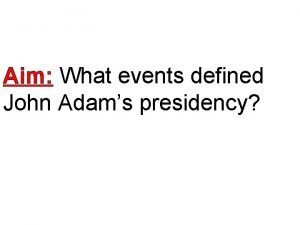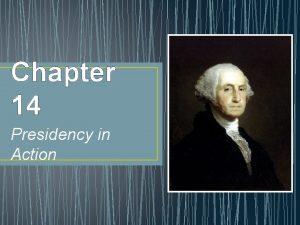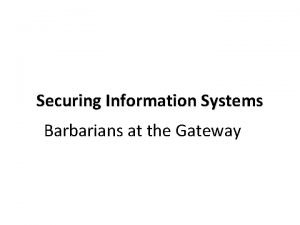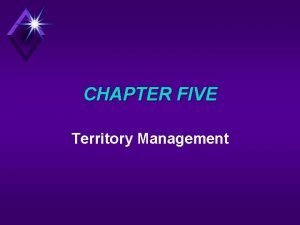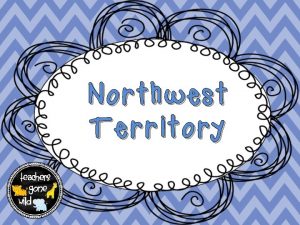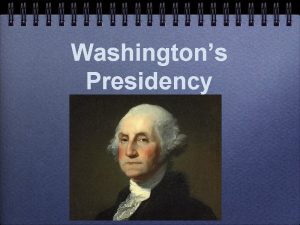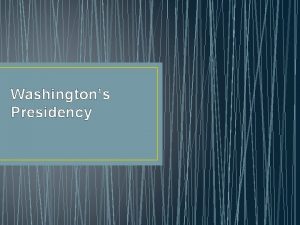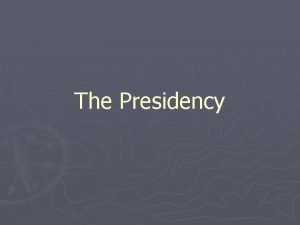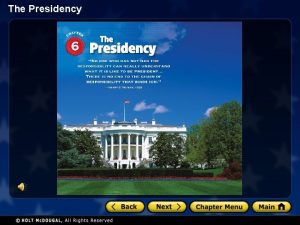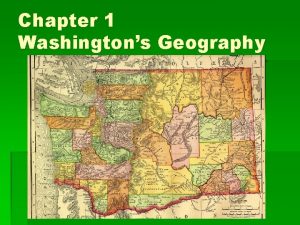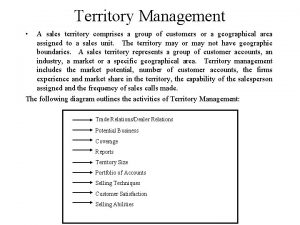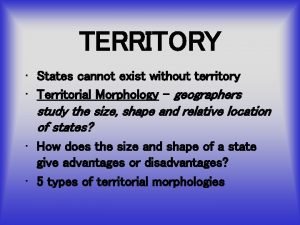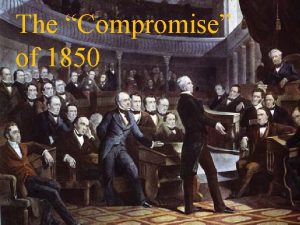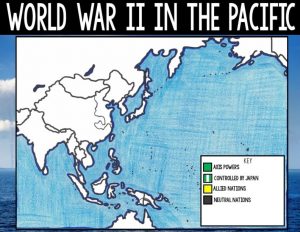Washingtons Presidency Part 2 Securing the Northwest Territory
















![“ Let me now. . . warn you. . . against the [harmful] effects “ Let me now. . . warn you. . . against the [harmful] effects](https://slidetodoc.com/presentation_image/49db87e2c44b1cca5c3ed509f96d13c6/image-17.jpg)












- Slides: 29

Washington’s Presidency Part 2

Securing the Northwest Territory Much of the land west of the Mississippi River belonged to Spain – including the Port of New Orleans. There was trouble between the Spanish and the Americans. Spain stirred up Native Americans against the white settlers AND threatened to cut the United States off from the Port of New Orleans.

Battle of Fallen Timbers In addition to the problems with the Spanish, on the lower Mississippi, Native Americans were at war with American settlers in the much disputed Northwest Territory. Washington sent troops to quell the Indian uprisings. At the Battle of Fallen Timbers in 1794, 2, 000 Chippewa, Shawnee, and Ottawa Indians were defeated by United States troops under General Anthony Wayne – known as “Mad Anthony” for his “reckless courage. ”

Treaty of Greenville The Native Americans fled the United States and retreated to British territory in Canada at Fort Miami. The British didn’t want more trouble with the United States, so they refused to help them. In 1795, the Native Americans signed the Treaty of Greenville surrendering all of their claims to the Northwest Territory.

The Whiskey Rebellion � Whiskey was a very important source of income for farmers living in the backcountry. Paper money was scarce on the frontier, so farmers used whiskey as a form of money – trading it for much needed supplies like salt and sugar. � Whiskey was also easier to ship than grain. So, farmers turned their grain into whiskey and shipped it in barrels down the Mississippi and across the Appalachians.

�Part of Alexander Hamilton’s financial plan was to raise government money by taxing products. He placed a tax on whiskey. Farmers in the backcountry didn’t have cash money to pay taxes. They used whiskey like cash – trading it for other goods. �In the summer of 1794, several farmers staged a rebellion against the Whiskey Tax. The beat a tax collector and tarred and feathered him.

Hamilton’s Views on the Whiskey Rebellion “ Such a resistance is treason against society, against liberty, against everything that ought to be dear to a free, enlightened, and prudent people. To tolerate it were to abandon your most precious interests. Not to subdue it were to tolerate it. ” Alexander Hamilton, The Works of Alexander Hamilton Class Discussion: What do you think of Hamilton’s view?

Washington had to make a decision. If he were to allow the rebellious farmers to get away with their actions, he would be setting a dangerous precedent for the future. In October 1794, General Henry Lee, along with Hamilton, marched an army of 13, 000 men to western Pennsylvania to put down the rebellion. The farmers fled. Washington had made his point.

The French Revolution In 1789, the people of France staged a rebellion against their government. Many French people were starving and they felt the King and Queen didn’t care about their suffering. The French had seen the Americans rebel and overthrow the English King. They decided to do the same.

� At first, Americans, such as Thomas Jefferson, supported the French Revolution. But, by 1792, the revolution had become grotesquely violent. Thousands of French citizens were killed and the guillotine severed dozens of heads daily.

War Breaks out between France and Britain �The British were afraid that the revolution in France would lead to revolution in England. France soon declared war on Britain, Holland, and Spain.

�The War between the British and the French put the United States in an awkward position. The French had helped us win our revolution against England. Now, they wanted our help. �Washington declared that the United States would remain neutral, and Congress passed a law saying we wouldn’t side with one country or the other.

The British Harass the United States �In 1792, the British began harassing United States cargo ships. The British navy would attack the ships and steal their goods.

Jay’s Treaty �Washington sent Chief Justice John Jay to England to convince the British to stop taking U. S. ships. �Afraid of more trouble with the United States, England signed Jay’s Treaty promising to leave U. S. ships alone AND to vacate the Ohio Valley completely.

Pinckney’s Treaty � Once the problems with England were resolved, Washington turned his attention to the problems with Spain. � Thomas Pinckney arranged a treaty with Spain in which the Spanish promised not to interfere with United States access to the Port of New Orleans.

Washington Retires �By the end of his second term, Washington had decided that eight years as president was enough. He wanted to go home. �In 1797, George Washington retired. In his farewell speech he warned of two things: “foreign entanglements” and “the spirit of party. ”
![Let me now warn you against the harmful effects “ Let me now. . . warn you. . . against the [harmful] effects](https://slidetodoc.com/presentation_image/49db87e2c44b1cca5c3ed509f96d13c6/image-17.jpg)
“ Let me now. . . warn you. . . against the [harmful] effects of the spirit of party. . this spirit, unfortunately. . Exists in different shapes in all governments. . . but in those of the popular form, it is seen in its’ greatness rankness and is truly their worst enemy. ” Class discussion: Do you think party politics are a positive or a negative in the United States ?

Washington’s Parting Advice on Foreign Policy �In addition to warning against party politics, Washington warned against “foreign entanglements. ” �He urged the nation to stay neutral: “steer clear of permanent alliances with any portion of the foreign world. ” Class Discussion: Who are our allies today? Do our alliances help or hurt us?

Growth of Political Parties �Following Washington, John Adams was elected president. Adams was a Federalist. His ideas differed from the anti-federalists on many issues. �Thomas Jefferson and James Madison were antifederalists. They joined with others to form the Democratic – Republican Party. �In spite of Washington’s warning, two parties emerged.

The First Political Parties Federalists Democratic Republicans Strong national government Limited national government Fear of mob rule Fear of rule by one person or a Loose interpretation of the Strict interpretation of the Constitution Economy based on manufacturing and shipping Supporters: lawyers, merchants, manufacturers, and clergy powerful few. Constitution Opposed the National Bank Economy based on farming Supporters: farmers and tradespeople

John Adams Becomes President �The election of 1796, was the first in which party politics were involved. �The Federalists wanted John Adams for president. �The Democratic Republicans wanted Thomas Jefferson.

�The electoral votes came in: Adams received 71, and Jefferson 68. Before the Constitution was amended to set things up the way we do them today, the first place winner became president and the second place vice – president. �This means we had a Federalist President and a Democratic Republican Vice President. �Why do you think we changed this system with an amendment to the Constitution?

Problems with France was under a new government after the revolution. The relationship with the French and the United States was not good. French naval vessels had begun capturing American vessels at sea to keep them from trading with the British. Many people thought the United States should go to war with France.

The XYZ Affair � To avoid war, Adams sent Charles Pinckney, Elbridge Gerry, and John Marshall to France to meet with the French minister of foreign affairs. � For many weeks, the French minister refused to see the Americans. � Finally, three men approached the American ambassadors and said the minister would see them but only if America would lend France 10 million dollars and give a bribe of 250, 000. � The American ambassadors refused: “Millions for defense, not one cent for tribute. ” � When citizens of the United states found out about this, they were enraged with the new French government.

The Alien and Sedition Acts �The Democratic Republicans were very critical of John Adams was angry over the criticism. Many new immigrants to America joined the Democratic Republican Party. �To slow the rise of the Democratic Republicans, Adams passed the Alien and Sedition Acts.

�The Alien and Sedition acts targeted immigrants. �One act extended the waiting period to become a U. S. citizen from 5 to 14 years. �Another act, said that the president could have disloyal aliens arrested and deported. �The most controversial act outlawed sedition. Sedition is writing or saying anything false or harmful about the government Class Discussion: Were the Alien and Sedition Acts Constitutional? If not, which of the Bill of Rights were violated by these acts.

State’s Rights �The Democratic – Republicans spurred on by Thomas Jefferson, wanted to do something about the Alien and Sedition Acts. They felt they were unconstitutional. �To fight the Alien and Sedition Acts, they came up with theory of “State’s Rights”. According to this theory, a state didn’t have to obey a law they felt violated the Constitution. The state could “nullify” or void the law. �This theory was important, not because it did much to get rid of the Alien and Sedition Acts, but because it came up again and again over issues such as tariffs and slavery.

Peace With France �John Adams did manage to eventually work things out with France. The French agreed to leave United States ships alone.

�However, Adams’ reputation was hurt by the Alien and Sedition Acts. �In the election of 1800, Thomas Jefferson and the Democratic Republican Party won.
 Securing the northwest territory
Securing the northwest territory George washingtons presidency
George washingtons presidency Lesson quiz 9-1 the federalist era
Lesson quiz 9-1 the federalist era Northwest territory
Northwest territory George washingtons phobia
George washingtons phobia George washingtons phobias
George washingtons phobias George washingtons terms
George washingtons terms Biomes in washington
Biomes in washington Washingtons precedents
Washingtons precedents George washingtons domestic policy
George washingtons domestic policy Lesson 2 early challenges
Lesson 2 early challenges Presidency line of succession
Presidency line of succession Chapter 20 politics of the roaring twenties answer key
Chapter 20 politics of the roaring twenties answer key Chapter 6 section 1
Chapter 6 section 1 Unwritten qualifications for president
Unwritten qualifications for president Institutional presidency definition
Institutional presidency definition Chapter 14 section 1 the growth of presidential power
Chapter 14 section 1 the growth of presidential power Chapter 12 section 2 the harding presidency
Chapter 12 section 2 the harding presidency Thomas jeffersons presidency
Thomas jeffersons presidency Chapter 12 section 2 the harding presidency
Chapter 12 section 2 the harding presidency Chapter 13 the presidency
Chapter 13 the presidency Constructionist presidency
Constructionist presidency Section 4 the presidency of john adams
Section 4 the presidency of john adams Xyz affair summary
Xyz affair summary President appointment power
President appointment power Which trend characterized thomas jefferson's presidency?
Which trend characterized thomas jefferson's presidency? Securing windows 7
Securing windows 7 Securing information systems summary
Securing information systems summary Chapter 8 securing information systems
Chapter 8 securing information systems Securing information systems
Securing information systems


